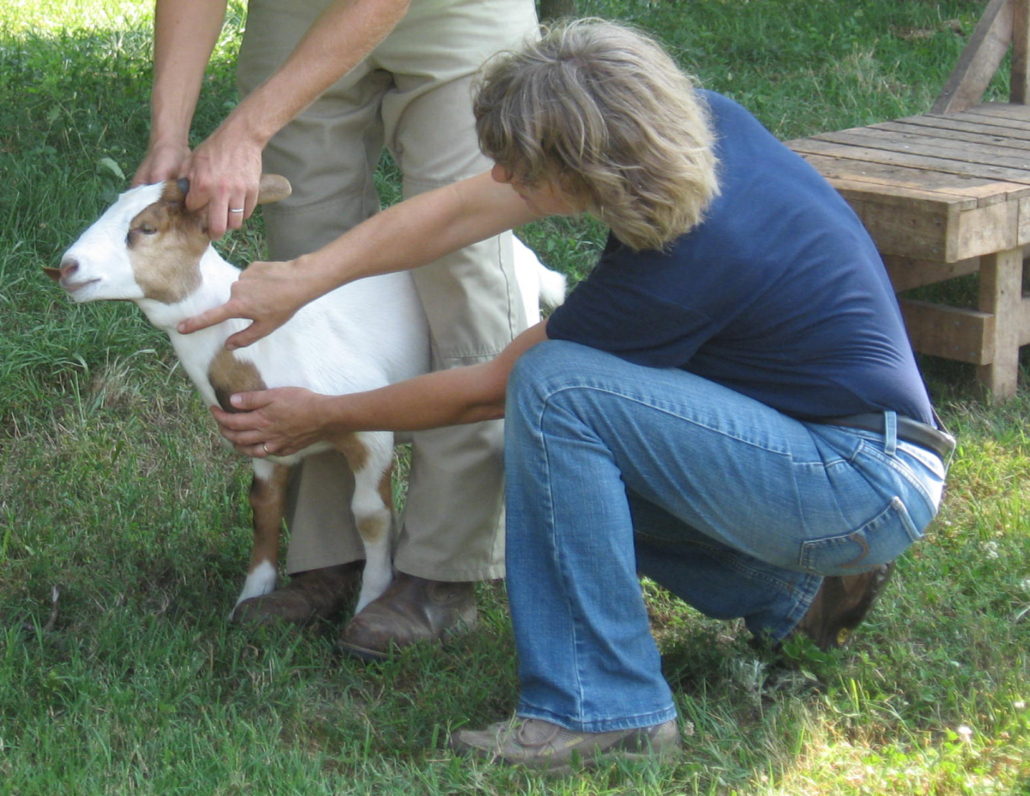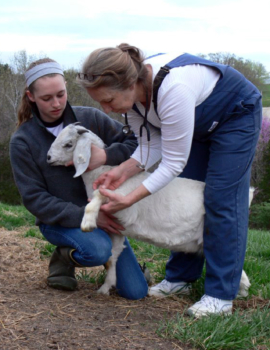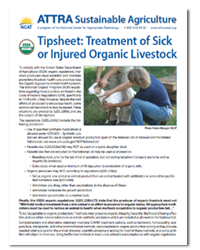Tipsheet: Treatment of Sick or Injured Organic Livestock

Photo: Robyn Metzger, NCAT
By Linda Coffey, NCAT Agriculture Specialist
To comply with the U.S. Department of Agriculture (USDA) organic regulations, livestock producers must establish and maintain preventive livestock health care practices (see Organic Approach to Animal Health tipsheet). The National Organic Program (NOP) regulations regarding these practices are found in the Code of Federal Regulations (CFR), specifically in 7 CFR §205.238(a). However, despite the best efforts of producers to encourage health, some animals will become ill or may be injured. These situations are covered by §205.238(b), and are the subject of this tipsheet.
The regulations [§205.238(b)] include the following provisions:
- Use of specified synthetic medications is allowed under §205.603—Synthetic substances allowed for use in organic livestock production (part of the National List of Allowed and Prohibited Substances.
- Parasiticides [§205.603(a)(18)] may NOT be used on organic slaughter stock
- Parasiticides that are included on the National List may be used as allowed on:
- Breeding stock, prior to the last third of gestation, but not during lactation if progeny are to be sold as organically produced
- Dairy stock, when used a minimum of 90 days prior to production of organic milk
- Organic producers may NOT, according to regulations [§205.238(c)]:
- Sell as organic any animal or animal product from an animal treated with antibiotics or some other prohibited substance (see [§205.604])
- Administer any drug, other than vaccinations, in the absence of illness
- Administer hormones for growth promotion
- Administer parasiticides on a routine basis
Finally, the USDA organic regulations [§205.238(c)(7)] state that the producer of organic livestock must not “Withhold medical treatment from a sick animal in an effort to preserve its organic status. All appropriate medications must be used to restore an animal to health when methods acceptable to organic production fail…”
To be “acceptable to organic production,” methods must preserve organic integrity; have the likelihood of being effective; and use either natural substances or certain synthetic substances which are included as allowed on the National List.
Complementary and alternative veterinary medicine (CAVM) treatment options, such as herbalism, homeopathy, acupuncture, chiropractic, and other nontraditional methods, are acceptable to organic production as long as they provide needed relief and care for the animal. However, scientific evidence is lacking for most of these methods, and some certifiers will object to their use. Using ineffective methods to treat a sick animal is noncompliance with organic regulations.
Before using any new medication or ingredient in your organic operation, be sure that you include each product, with its complete product brand name and manufacturer, on your Organic System Plan (OSP), and obtain your certifier’s approval for its intended use in your operation.
Working with a Veterinarian

It is very important to establish a good working relationship with a veterinarian. Photo: Grace Rathert
Finding a veterinarian who will support you as a herd-health partner will pay dividends. Establishing a working relationship with a veterinarian in advance lays a helpful groundwork for the day when an animal needs veterinary care. Paying attention to these points will benefit you, your veterinarian, and your livestock:
- Ask other organic livestock producers in your area if they can recommend a veterinarian who is familiar with organic production systems.
- If not, ask other producers in your area for a referral.
- Set up an appointment for an initial farm visit so the veterinarian can see the whole setup before there are any problems. You will pay for this visit, but it is money well spent.
- Consult the veterinarian about recommendations for vaccination protocol and other preventive strategies to employ in your operation.
- Discuss your nutritional program with your veterinarian and gather nutritional advice, or seek a referral to a nutrition consultant if needed.
- Share information regarding acceptable organic treatment options:
- Give the veterinarian a copy of the National List.
- Ask your certifier for any other list that will be a reliable indicator
of the status of materials allowed per organic regulations. Two that are widely accepted are Organic Materials Review Institute (OMRI) Lists, and the Washington State Department of Agriculture Organic Input Material List. - Remind the veterinarian that any products used must be approved by the certifier prior to use.
- Provide the veterinarian with books (or a list of books; see Resources list below) that can be educational concerning organic treatment options.
- Observe your livestock closely. Know the signs of health (and lack thereof), and be responsive to signs that an animal is not well.
- Call your veterinarian in a timely manner; do not wait until the animal is too ill to be helped.
- If treatment is not effective, consult your veterinarian to determine what actions to take next. If your animal is not responding to organically approved health-care methods, you must use conventional treatments to prevent suffering.
- Identify the reasons for animal deaths. Post-mortem evaluations can give vital information to help you and your veterinarian improve health practices to prevent further losses.
- Keep careful records about all illnesses and death losses. Review them with your veterinarian periodically to look for patterns that may suggest the weak area in the system. (For example, if most illnesses are nutrition-related, improving the nutritional program will be an important measure to take.)
- If death loss is excessive, ask your veterinarian to visit the farm again and help you troubleshoot the situation. Preventative health care is a necessary component of organic production.
Recordkeeping and the Organic System Plan
Your OSP must detail preventive measures and must list all substances you plan to use for treatment of sick or injured animals (including those that would negate the animal’s organic status). Keep purchase records and labels and be ready to show them to your inspector. Also keep records of all illnesses, treatments used, outcomes, and status of the animal. For example, if you treated ewe 853 with anthelmintic during lactation, her nursing lambs must be marketed as NONORGANIC, and identified in the records as such. Sale records should verify that they were sold as nonorganic. Your inspector will need to check these records. Identifying nonorganic animals so that they cannot accidentally be sold as organic is important. They do not have to be physically segregated from organic animals during grazing or management if they can be identified and separated before sale. Installing a different-colored ear tag, for example, will be a great help.
Notify your certifier, receive approval, and update your OSP before you use any new products.
Questions
Are you using organically acceptable strategies and techniques to treat, control, and/or prevent diseases and injuries in livestock [§205.105 and also §205.603]? Allowed options include, but are not limited to, the following:
- Selective breeding
- Quarantine of newly purchased, injured, or diseased animals
- Sanitation
- Examining living quarters and removing any hazards
- Vaccinations
- Nutritional therapy
- Aseptic protocols during vaccinations, physical alterations, and surgical procedures
- Use of electrolytes, glucose, and dextrose
- Vitamin therapy used for enrichment or fortification when FDA approved
- Probiotics (includes colostrums, which must not be from a genetically engineered source)
- Iodine
- Hydrogen peroxide
- Some conventional veterinary medicines, as listed on the National List, and used only as allowed (some annotations or restrictions apply)
The following strategies are allowed but may not be effective. Use them only when they might reasonably be considered capable of helping the animal, either because research has shown that they work in the given situations, or because your veterinarian agrees that they might be efficacious. Use of these methods when an appropriate, though prohibited, method is available may be a violation of the regulations:
- Homeopathy
- Herbal remedies
- Acupuncture
- Chiropractic
Prohibited materials and techniques include, but are not limited to, the following:
- Antibiotics (required if necessary; animal loses organic status)
- Genetically modified probiotics
- Synthetic growth or breeding hormones
- Most conventional veterinary medications (required if necessary; animal loses organic status)
- Parasiticides not on the National List (required if necessary; animal loses organic status)
Do you keep records of all animal-health products used, along with their purchase receipts and labels? Are all listed on your OSP?
Do your herd/flock health records accurately document all health treatments given and/or procedures performed?
Are your herd/flock health records adequate to track animals treated with prohibited materials to ensure that they are not sold as organic?
If livestock become sick or injured, do you take action and apply the necessary medications to restore health regardless of the consequences to the animal’s organic status?
Are you using allowed medications solely for the purposes of restoring animal health? (Drugs may not be administered to enhance animal growth or performance. Medications are allowed only for the treatment of injury or disease.)
Do you have a working relationship with a veterinarian who has been informed of your livestock’s organic status?
Further Resources
USDA Organic Regulations 7 CFR 205
USDA National Organic Program Handbook
See especially the following documents:
- 5025: Commingling and Contamination Prevention in Organic Production and Handling
- 2602: Recordkeeping of Certified Operations
USDA National List of Allowed and Prohibited Substances
USDA National Organic Program Website
Herd Health on Organic Dairy Farms, by Lisa McCrory
Decoding Organic Dairy Healthcare Labels, by Cheryl Cesario
Acres U.S.A.
Publishes several books that will be helpful to both veterinarians and producers:
- Alternative Treatments for Ruminant Animals, by Dr. Paul Dettloff (2004, 254 p.)
- Treating Dairy Cows Naturally, by Dr. Hubert J. Karreman (2004, 2007, 412 p.)
- The Barn Guide to Treating Dairy Cows Naturally, by Dr. Hubert J. Karreman (2011, 192 p.).
ATTRA Publications
Documentation Forms for Organic Crop and Livestock Producers
Tipsheet: Living Conditions, Facilities, and Handling for Organic Livestock
Organic and Grass-Finished Beef Cattle Production
Raising Organic Pigs: A Guide to USDA Certified Organic Requirements
Tipsheet: Treatment of Sick or Injured Organic Livestock
By Linda Coffey, NCAT Agriculture Specialist
Published July 2015
IP510 Slot 523
This publication is produced by the National Center for Appropriate Technology through the ATTRA Sustainable Agriculture program, under a cooperative agreement with USDA Rural Development. This publication was also made possible in part with support from U.S. Department of Agriculture’s Agricultural Marketing Service, National Organic Program. ATTRA.NCAT.ORG.


